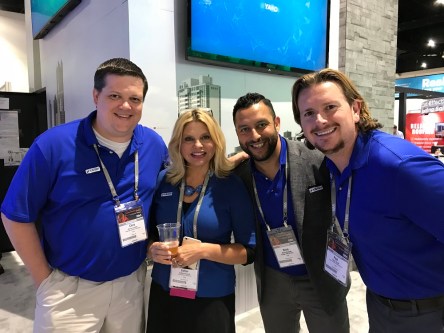At Maximize powered by NAA, the annual conference dedicated to asset and revenue management and long-term value creation for apartment portfolios, industry pros talked about how changes in the economy — including an expected downturn ahead — will impact multifamily revenue management. This year’s sessions covered renovations and amenities in some detail, with panelists speaking about the importance of flexible strategies when navigating changing markets. For example, there might be less demand than anticipated for high-end renovations. Conversations also turned to smart home technology including self-showing programs, and short-term rentals as a new revenue stream that would be increasingly compelling in struggling rental markets. While some attendees have only known growth, experienced revenue managers who maneuvered through the last recession shared tactics and valuable lessons learned. Although it’s unclear exactly when the next downturn will happen, the consensus at Maximize was it will happen. And the sooner you’re ready for it, the better. Curveballs ahead So how do you prepare for a downturn? Experts agree that having a well-informed revenue management strategy in place is crucial, and that means having tools to collect data to uncover trends and follow patterns in order to make smart decisions. Beyond finding the sweet spot for rental pricing, auditing your properties for other ways to boost performance is also a great idea — including assessing amenities and reducing unnecessary expenses. In addition to knowing how to price units based on inventory and market conditions, the most effective revenue managers also know every selling point of each property in their portfolio. With the advent of artificial intelligence and machine learning to guide asset management, sometimes the computer knows what’s happening before people do. In times of both growth and recession, the most successful revenue managers will be using a...
Artificial Intelligence...
Q&A WITH GARY SMITH
Artificial intelligence—defined in the Oxford English Living Dictionary as “the theory and development of computer systems able to perform tasks normally requiring human intelligence”—is booming. Last year, technology market intelligence p rovider International Data Corporation forecasted a 54.4% compound annual growth rate of corporate global spending on cognitive and AI solutions through 2020, when AI-related revenues will top $46 billion. In 2016, global financial advisor UBS said, “We expect AI’s industry growth will start to explode and its impact on business and society will begin to emerge” by the end of the decade, pointing to a future where “AI-powered machines and software will likely start to untether from human supervision, embarking on their fateful path as sentient beings.” AI proponents tout such potential benefits as efficiency, elimination of manual tasks and new solutions for social problems. But not everybody is on the wagon. In 2015, for example, a host of business and academic leaders including Elon Musk, Steve Wozniak and the late Stephen Hawking signed an open letter urging restraint in the development and application of AI. “It is important to research how to reap its benefits while avoiding potential pitfalls,” the signatories said. Gary Smith, a professor of economics at Pomona College in Claremont, Calif., and author of the just-published book, “The AI Delusion,” also advises caution. Professor Smith offered his thoughts in an interview with The Balance Sheet. Q: Professor Smith, what do you see as the biggest misconception about artificial intelligence? A: That computers are smarter than humans. AI algorithms excel at narrowly defined tasks that have clear goals, such as tightening bolts, checkmating a chess opponent or reducing a building’s energy consumption. These tasks can be very useful, but AI doesn’t “think” in any real sense of the word. Q:...
Smart Future
Multifamily AI Panel
What is artificial intelligence (AI)? According to Wikipedia, it is “The artificially created ability of a digital computer or computer-controlled robot to perform tasks commonly associated with intelligent beings.” While this definition of AI sounds like something from a sci-fi movie script, it actually describes technology currently poised to transform multifamily real estate management. Yardi’s Dharmendra Sawh, industry principal of Yardi Elevate, led a panel of experts at NAA Apartmentalize on June 14 in San Diego for “The Age of AI: Business Intelligence Today and Tomorrow.” Apartmentalize is NAA’s annual educational conference and is the premier resource for educating rental housing industry professionals. Along with Michael Barry, vice president of data analytics at Bozzuto Management Company, Tim Reardon, chief operating officer of Bridge Property Management and Dawn Wise, national financial analyst at Berkshire Communities, Sawh discussed best practices for business intelligence (BI) today and the looming impact of AI on multifamily business technologies. “BI tools deliver analytics to provide foresight, improve business decisions and increase your competitive edge. But soon, your software could be making those decisions for you. Tracking the right measures can help future-proof your analytics in anticipation of AI,” said Sawh. The presentation covered which performance measures are most important, how technology can track that data and how to analyze and act on that information to create a successful business strategy. The session wrapped with a preview of what’s coming for multifamily owners and managers with advancements in AI. Beyond BI The panel discussed predictive and prescriptive analytics for real estate management, and the role machines will play as interpreters of data. Machine learning is a component of AI that uses historical information and correlates multiple data points to make predictions about the future — and as a result, becomes more...
NAA 2018
Lessons from Apartmentalize
The multifamily industry converged in San Diego last week for Apartmentalize Powered by National Apartment Association. Formerly known as the NAA Education Conference and Exposition, the annual event is the largest educational conference for apartment industry professionals. We highlight five of our favorite lessons from this year’s event. 5 Lessons from Apartmentalize 2018: Own the Age of AI On Thursday, industry experts discussed the impact of artificial intelligence in multifamily. Panelists included Dawn Wise from Berkshire Communities, Michael Barry from Bozzuto, Tim Reardon from Bridge Property Management, and Yardi’s Dhar Sawh. Artificial intelligence has just recently emerged in the rental housing industry. “This is so new for our industry, so the sky’s the limit,” explained Reardon. The session explored the benefits of artificial intelligence, big data, and business intelligence tools. How can you get energized for the Age of AI? Top tips from panelists: learn more about AI, and make a data strategy plan. Today’s Renters Have a Multi-Touch Journey Over the last two decades, we’ve gone from tracking walk-ins and phone calls to embracing comprehensive CRM systems. On a panel moderated by Yardi’s Esther Bonardi, Holli Beckman from WC Smith, Israel Carunungan from Greystar, and Mia Wentworth from CWS Apartment Homes discussed multi-touch lead attribution, a model for tracking and weighing touchpoints in the lead-to-lease cycle. How can smart marketers improve lead tracking? “Dig into it, study it, and it can open a whole new world,” advised Bonardi. Learn more about multi-touch lead attribution and download our free eBook. Sustainability Wins At Friday’s Apartmentalize session, panelists including Yardi’s Martin Levkus explored resident engagement through energy efficiency. In a recent National Apartment Association survey, windows were the top sustainability item residents cared about. For one panelist, energy efficient windows resulted in a $75 per month...
Watch Out Fido
Aibo is Back
Just in time for the holidays, Sony has resurrected the robot pet it removed from shelves in 2006. This new model is called aibo, which stands for Artificial Intelligence robot. Aibo is also the Japanese word for “companion” or “friend.” The new model (no. ERS-1000) develops from a newborn puppy to an adult with personality shaped by the interaction with its owners and surroundings, thanks to the latest AI technology. This ability to form an emotional bond with members of the family makes each aibo unique, so no two will be the same. The new puppy’s rounded appearance makes it pretty irresistible. Sony has spent quite a bit on animation. That being said, I am personally a bit skeptical about how it feels to pet a piece of plastic, even though it’s premium plastic. The pup has the capacity of expressing its love for its owners through lifelike expressions and a dynamic array of movements, but it does make one wonder—is this the future of pets? The robot pet has a behavioral repertoire more limited than that of the least bright dog, but an aibo doesn’t need you to feed it (technically, it does when you charge it), doesn’t wake you up at 5am to take it out in the pouring rain and will never make a mess inside your home. Aibo’s ‘fur’ is ivory-white, and it has cute flapping black ears and a wagging tail. It’s about 30-centimeters long and comes with a package of sensors on the head, chin and back for pet detection, two cameras, four microphones for voice commands and internet connectivity, as well as the earlier mentioned upgraded AI backed by cloud computing to develop the dog’s personality. The advantages of deep learning and AI tricks help it to...
Zuckerberg’s AI...
Meet Jarvis
Mark Zuckerberg recently unveiled his personal AI assistant, Jarvis. It seems to be one of his most curious inventions. In addition to his work at Facebook, Zuckerberg takes on self-development challenges, like learning Mandarin. In early 2016, he committed to an even more ambitious project: to build an Iron Man-inspired artificial intelligence (AI) system to help him around the house. The transition from database software creation like Facebook to AI is a massive leap, even for a mind like Zuckerberg’s. AI is intelligence exhibited by a machine. It is a flexible rational agent that perceives its environment and takes actions that maximize its chance of success at some goal. Zuckerberg’s creation resembles Marvel’s Iron Man Comics and Movies’ J.A.R.V.I.S, and not just by name. Like Tony Stark, Zuckerberg aimed to build a system that could control his home, including lights, temperature, appliances, music and security. He also wanted Jarvis to learn his tastes and patterns, new words and concepts. Zuckerberg brought J.A.R.V.I.S to life–basically. The video above is intended for presentation proposes rather than an actual demo of the AI robot. It’s a bit unclear what is actually real and what is overproduced. Here is what we know: Zuckerberg’s Jarvis comes with a variety of impressive features, not the least of which is the voice of God, Morgan Freeman. Natural language processing, speech recognition, and face recognition software make interacting with Jarvis as natural as carrying out a conversation with a friend. He even has a sense of humor. The AI includes smart home features. His vision (via cameras and customized software) can tell people and objects apart, and detect movement. Zuckerberg also installed unique features in the house and connected them to Jarvis, including the toaster and a t-shirt cannon that dispenses clothing...






